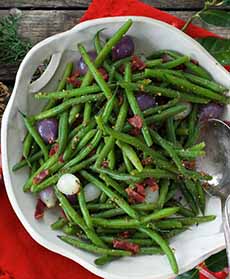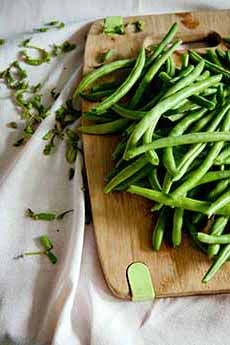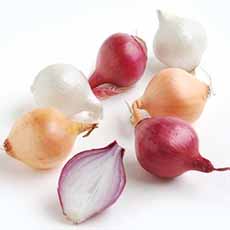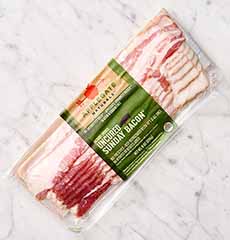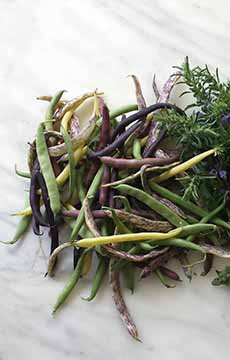RECIPE: Green Bean Salad With Bacon Vinaigrette & Bacon Garnish
|
If your salads have the winter blahs, you can revive them with bright red vegetables, fruits (apples, pears, dried cranberries, pomegranate arils), other colorful produce, and nuts. Another idea: Make this snappy salad with green beans instead of lettuce. You can make it with cooked green beans, but we like the beans to be raw and crunchy. You can also add, or substitute, baby potatoes for the pearl onions. You can also add slices of sweet onion (or if you prefer, pungent red onion). A sharp Dijon vinaigrette and a generous scattering of crisp bacon complete the recipe. > The history of green beans is below. Thanks to Applegate for this recipe, which uses Applegate Naturals® Sunday Bacon® Brand in the recipe. This naturally cured bacon, imbued with a delightful hickory smoked flavor is minimally processed with no artificial ingredients, no preservatives, and is gluten-free. Prep and cook time is less than 30 minutes. 1. WASH and trim the green beans. If serving them raw, set aside. If not, bring a large pot of well-salted water to a boil. Add the beans and boil until bright green and tender, about 5 minutes. 2. USE tongs to scoop out the beans and place in a colander to drain. Set aside. Add the pearl onions to the boiling water and boil until tender, about 5 minutes. Drain well. When cool enough to handle, trim and peel the onions. 3. COOK the bacon in a skillet over medium heat, stirring occasionally, until it is very crisp, about 10 minutes. Using a slotted spoon, transfer the bacon to a plate lined with paper towels. Measure into a cup how much bacon fat is in the pan; there should be about 2 tablespoons. 4. RETURN the bacon fat to the skillet over medium-low heat and add enough olive oil to equal 4 tablespoons total fat. Add the mustard and cider vinegar and stir to combine well. Season to taste with salt and pepper. 5. TOSS the green beans and the onions with the hot dressing; taste and adjust the seasonings. Transfer the vegetables to a serving dish and top with the crisp bacon. Green beans (Phaseolus vulgaris), also known as string beans or snap beans and originally called string beans, have existed for thousands of years. They have a long history of cultivation. Archaeological evidence from Mexico suggests that green beans were cultivated there more than 7,000 years ago. They are native to Central and South America and likely originated in what is now Peru. Spanish explorers are credited with bringing green beans to Europe. By the 16th century, green beans were being cultivated in European gardens. Over time, different varieties of green beans were developed. French green beans (haricots verts), known for their slender shape and tender texture, gained popularity in Europe. Green beans made their way to North America through European colonization. They became a staple in colonial gardens and were widely consumed by early American settlers. Their ease of cultivation and nutritional value contributed to their popularity as a garden vegetable. In the 19th century, selective breeding began to eliminate the tough, fibrous strings that were naturally present in string beans and had to be removed before cooking. Around 1894, a plant breeder named Calvin N. Keeney released the first stringless green bean called the “Stringless Green Pod,” which became popular for its tender and easy-to-eat pods. The invention of stringless green beans contributed to further popularity in home gardens and commercial agriculture. With advancements in food preservation techniques, green beans became one of the vegetables commonly canned for convenience and long-term storage. |
|
|
|
As with all vegetables, today, there are numerous varieties of green beans available. Green beans and yellow wax beans are the same species and genus, but they have been selectively bred to express different traits such as pod color. There are also beautiful purple beans that turn green when cooked. The genus and species belongs to the family Fabaceae or Leguminosae, commonly known as the legume, pea, or bean family. Green beans are enjoyed in cuisines worldwide, both fresh and cooked. CHECK OUT WHAT’S HAPPENING ON OUR HOME PAGE, THENIBBLE.COM.
|
||
